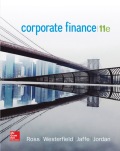
a.
To compute: Value of a risk free bond.
Bonds:
Bond is that item, which is similar to stock but the bonds carries some sort of interest and discount elements as well. It can be zero coupon bond, risk free or any other. There are various types of bonds, which changes according to the company on which type of bond they want to use.
a.
Explanation of Solution
Given,
Face
Risk free rate is 0.05.
Time to maturity is 2 years.
Formula to calculate value of a risk free bond is:
Where,
- PV is
present value of a risk free bond. - FV is face value of the bond.
- R is risk free rate.
- T is time to expire.
Substitute $75,000 for FV, 0.05 for R and 2 for T,
Thus, the value of the risk free bond of ML Industries is $67,862.77.
b.
To compute: Price paid by the bondholders for put option.
b.
Explanation of Solution
Given,
Stock price is $46,000.
Exercise price is $75,000.
Risk free rate is 0.05.
Time to maturity is 2 years.
Formula to calculate price of a call option is:
Where,
- S is stock price.
- E is exercise price.
- R is risk free rate.
- T is time to expire.
Substitute $46,000 for S, $75,000 for E, 0.05 for R and 2 for T,
Formula to calculate price of put option by put call parity is:
Where,
- C is price of call option.
- P is price of put option.
- S is stock price.
- E is exercise price.
- R is risk free rate.
- T is time to expire.
Substitute $9,594.80 for C, $46,000 for S, $75,000 for E, 0.05 for R and 2 for T,
Working notes:
Calculation of
From
Formula to calculate
Calculation of
From normal distribution table
Hence, price that would the bondholders have to pay for a put option on the company’s assets is $31,457.57.
c.
To compute: Value of company’s debt and the continuously compounded yield on the company’s debt.
c.
Explanation of Solution
Given,
Value of risk free bond is $67,862.77.
Value of put option is $31,457.57.
Time to maturity is 2 years.
Formula to calculate the value of firm’s debt is:
Substitute $67,862.77 for value of risk free bond and $31,457.57for value of put option,
Formula to calculate present value of firm’s debt is:
Substitute $36,405.2 for the present value of firm’s debt, $75,000 for future value of debt and 2 for T,
Hence, value of the company’s debt is $36,405.2 and the continuous compounded yield on company’s debt is 36.14%
d.
To compute: Value of debt under proposed plan and the new continuously compounded yield on the debt.
d.
Explanation of Solution
Given,
Face value of the bond is $75,000.
Stock price is $46,000.
Risk free rate is 0.05.
Time to maturity is 5 years.
Formula to calculate value of a risk free bond is:
Where,
- PV is present value of a risk free bond.
- FV is face value of the bond.
- R is risk free rate.
- T is time to expire.
Substitute $75,000 for FV, 0.05 for R and 5 for T,
Formula to calculate price of a call option is:
Where,
- S is stock price.
- E is exercise price.
- R is risk free rate.
- T is time to expire.
Substitute $46,000 for S, $75,000 for E, 0.05 for R and 5 for T,
Formula to calculate price of put option by put call parity is:
Where,
- C is price of call option.
- P is price of put option.
- S is stock price.
- E is exercise price.
- R is risk free rate.
- T is time to expire.
Substitute $19,932.195 for C, $46,000 for S, $75,000 for E, 0.05 for R and 5 for T,
Formula to calculate the value of firm’s debt is:
Substitute $58,410for value of risk free bond and $32,342.2 for value of put option,
Substitute $26,067.8 for the present value of firm’s debt, $75,000 for future value of debt and 5 for T,
Working notes:
Calculation of
From normal distribution table
Calculation of
From normal distribution table
Hence, value of the company’s debt under given plan is $26,067.8 and the continuous compounded yield on company’s debt is 21.13%.
Want to see more full solutions like this?
Chapter 22 Solutions
EBK CORPORATE FINANCE
 Intermediate Financial Management (MindTap Course...FinanceISBN:9781337395083Author:Eugene F. Brigham, Phillip R. DavesPublisher:Cengage Learning
Intermediate Financial Management (MindTap Course...FinanceISBN:9781337395083Author:Eugene F. Brigham, Phillip R. DavesPublisher:Cengage Learning EBK CONTEMPORARY FINANCIAL MANAGEMENTFinanceISBN:9781337514835Author:MOYERPublisher:CENGAGE LEARNING - CONSIGNMENT
EBK CONTEMPORARY FINANCIAL MANAGEMENTFinanceISBN:9781337514835Author:MOYERPublisher:CENGAGE LEARNING - CONSIGNMENT

